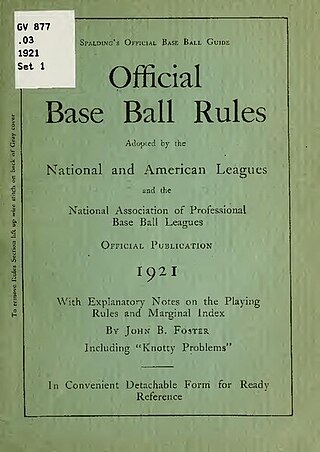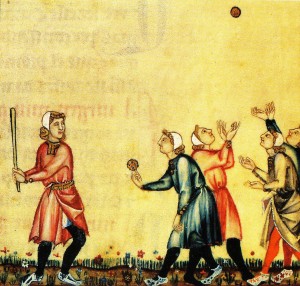A mercy rule, slaughter rule, knockout rule, or skunk rule ends a two-competitor sports competition earlier than the scheduled endpoint if one competitor has a very large and presumably insurmountable scoring lead over the other. It is called the mercy rule because it spares further humiliation for the loser. It is common in youth sports in North America, where running up the score is considered unsporting. It is especially common in baseball and softball in which there is no game clock and a dominant team could in theory continue an inning endlessly.

Tag is a playground game involving one or more players chasing other players in an attempt to "tag" and mark them out of play, usually by touching with a hand. There are many variations; most forms have no teams, scores, or equipment. Usually, when a person is tagged, the tagger says, "Tag, you're 'It'!" The last one tagged during tag is "It" for the next round. The game is known by other names in various parts of the world, including "running and catching" in India and "catch and cook" in the Middle East.
A draw or tie occurs in a competitive sport when the results are identical or inconclusive. Ties or draws are possible in some, but not all, sports and games. Such an outcome, sometimes referred to as deadlock, can also occur in other areas of life such as politics, business, and wherever there are different factions regarding an issue.
In a sport or game, sudden death is a form of competition where play ends as soon as one competitor is ahead of the others, with that competitor becoming the winner. Sudden death is typically used as a tiebreaker when a contest is tied at the end of regulation (normal) playing time or the completion of the normal playing task.
Overtime or extra time is an additional period of play specified under the rules of a sport to bring a game to a decision and avoid declaring the match a tie or draw where the scores are the same. In some sports, this extra period is played only if the game is required to have a clear winner, as in single-elimination tournaments where only one team or players can advance to the next round or win the tournament.

Extra innings is the extension of a baseball or softball game in order to break a tie.

Throughout the history of baseball the rules have frequently changed as the game has continued to evolve. The rules of baseball can vary slightly from league to league, with there being dozens of leagues worldwide. A few common rules most professional leagues have in common is that 4 balls is a Base on balls, 3 strikes is a strikeout and 3 outs ends a half inning. One example of differing rules in professional leagues is in Major League Baseball a pitch clock is in place to speed up the pace of the game by forcing pitchers to pitch in a 15-20 second window, where in the Nippon Professional Baseball League no such rule exists.

In sports, a time-out or timeout is a halt in the play. This allows the coaches of either team to communicate with the team, e.g., to determine strategy or inspire morale, as well as to stop the game clock. Time-outs are usually called by coaches or players, although for some sports, TV timeouts are called to allow media to air commercial breaks. Teams usually call timeouts at strategically important points in the match, or to avoid the team being called for a delay of game-type violation, such as the five-second rule in basketball.
In several team sports, matches are played in two halves. Half-time is the name given to the interval between the two halves of the match. Typically, after half-time, teams swap ends of the field of play in order to reduce any advantage that may be gained from wind or a slope to the playing surface, for example.
In games and sports, a tiebreaker or tiebreak is used to determine a winner from among players or teams when their scores are tied at the end of a contest, or a set of contests.
In baseball, an official game is a game where nine innings have been played, except when the game is scheduled with fewer innings, extra innings are required to determine a winner, or the game must be stopped before nine innings have been played, e.g. due to inclement weather. The term "official game" is mainly used in the context of a game that is stopped before nine innings have been played, though it has been used for other promotional purposes.

Bat-and-ball games are field games played by two opposing teams. Action starts when the defending team throws a ball at a dedicated player of the attacking team, who tries to hit it with a bat and run between various safe areas in the field to score runs (points). The defending team can use the ball in various ways against the attacking team's players to force them off the field when they are not in safe zones, and thus prevent them from further scoring. The best known modern bat-and-ball games are cricket and baseball, with common roots in the 18th-century games played in England.

In baseball, softball, and similar games, an inning is the basic unit of play, consisting of two halves or frames, the "top" and the "bottom". In each half, one team bats until three outs are made, with the other team playing defense. A full baseball game is typically scheduled for nine innings, while softball games consist of seven innings; although this may be shortened due to weather or extended if the score is tied at the end of the scheduled innings. The use of the term inning in baseball and softball contrasts with cricket and rounders, in which the term is innings in both singular and plural.

The 2009 American League Central tie-breaker game was a one-game extension to Major League Baseball's (MLB) 2009 regular season, played between the Detroit Tigers and Minnesota Twins to determine the champion of the American League's (AL) Central Division. It was played at the Hubert H. Humphrey Metrodome in Minneapolis, Minnesota, on October 6, 2009. The Twins won the game 6–5 in 12 innings and advanced to the 2009 AL Division Series where they were swept by the New York Yankees; the Tigers failed to qualify for the postseason.
Free substitution or rolling substitution is a rule in some sports that allows players to enter and leave the game for other players many times during the course of a game, generally during a time-out or other break in live play; and for coaches to bring in and take out players an unlimited number of times. In other sports, limited substitution restricts the manner in which players can be replaced.

Atya patya or atya-patya is a traditional Indian tag sport played by two sides of nine players. It is more popular in rural areas of India. It is more commonly played in Maharashtra, a western Indian state. Atya patya is described as a "game of feints". The playing area comprises nine trenches, coming out of either side of a central trench; a point is awarded to the attacking team's players for each trench they cross without being tagged out by the defensive players within the trenches. The game ends after 4 innings of 7 minutes each, with each team having two innings to score. It has been described as a game of "militant chase". The sport is played in a relatively small area and requires no equipment, similar to other games indigenous to India such as kabaddi, seven stones, kho kho, gillidanda and langdi.

Langdi is a traditional Indian field sport played in Pandiyan Dynasty called "Nondiyaattam", similar to hopscotch. The teams alternate chasing (attacking) and defending roles in each of the 4 innings of the game, with the chasing team's players restricted to hopping around on one foot, and attempting to score points by tagging as many defenders as possible within the 9 minutes of each inning. It is described by Marathis as a sport with a Marathi ethos.
A comeback is an occurrence of an athlete or sports team engaged in a competition overcoming a substantial disadvantage in points or position. It has been described as "the single greatest aspect of competition that most embodies the spirit of what makes sport extraordinary". It has been observed in spectator sports that "dramatic play seems to involve both players; cheering would often escalate when one player gained momentum, and then his/her opponent suddenly turned the tables and made a comeback", with such a result drawing more enthusiasm than one competitor defeating the other without giving up any points. Fans are likely to feel better about a team that loses after staging a "comeback that fell just short" than a team that lost by the same score after having played evenly throughout the match and then allowed the other team the winning score at the end.

There are a variety of traditional rural games in the historical region of Bengal. These games are typically played outside with very limited resources. Many of them have similarities to other traditional South Asian games. Nowadays, with urbanization, many traditional games are being played less and less.

South Asia has many traditional games and sports. Two of them, kabaddi and kho-kho, are played at the South Asian Games, with kabaddi also featuring at the Asian Games. Many of these games are played across the entire subcontinent under different names and with some rule variations, while some of these games may be played only in certain countries or regions.










